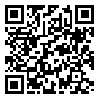BibTeX | RIS | EndNote | Medlars | ProCite | Reference Manager | RefWorks
Send citation to:
URL: http://payavard.tums.ac.ir/article-1-122-en.html
Background and Aim: Tuberculosis is an infectious disease with worldwide distribution. Based on WHO report one third of people are affected with mycobacterium tuberculosis. Today, the traditional bacteriological methods are only available using diagnostic methods for detection of tuberculosis. Innovation of a simple and efficient method for the diagnosis of tuberculosis is one of the most important aims of the world program against tuberculosis. The methods which are based on indicating of specific antibody response against mycobacterial antigens are potentially valuable for substituting traditional methods. These methods have attracted the researchers' attention for some reasons. Firstly the strong antibody response against mycobacterial antigens is detected only during active tuberculosis. Secondly the serologic methods are simple rapid, cheap and noninvasive. Thirdly, these methods in contrast to cutaneous PPD test are able to differentiate between an asymptomatic contamination with mycobacterium and active disease. In this study, a secretary glycoprotein antigen of mycobacteriurn tuberculosis, named 38 kD antigen, was used for a screening test for diagnosis of tuberculosis by immunodot method, since in previous researches, this antigen was considered as a special specific one in serological tests and showed much specificity.
Materials and Methods: In this study the results of immunodot tests on serum of 32 patients with pulmonary tuberculosis and positive sputum smear compared with 32 healthy people. Then, the results were compared with similar tests on protein was mixture of culture filtrate.
Results: Assay by using 38 kD antigen, resulted in 29 positive response among 32 patients, whereas by using protein mixture of culture filtrate, the test resulted in positive response in all patients (sensitivities are 90.6%, and 100% respectively). On the other hand, using 38 kD antigen resulted no positive response in assay with serum from healthy ones, but by using protein mixture from culture filtrate resulted in 8 positive response in healthy people (specificities 100% and 75% respectively).
Discussion and Conclusion: Results of this study showed the efficacy of using 38 kD antigen in rapid diagnosis of tuberculosis by immunodot method, because this method has more specificity and does not require sophisticated and expensive equipments. Thus this test may be used in field studies as a simple, precise and efficient test.
| Rights and permissions | |
 |
This work is licensed under a Creative Commons Attribution-NonCommercial 4.0 International License. |





